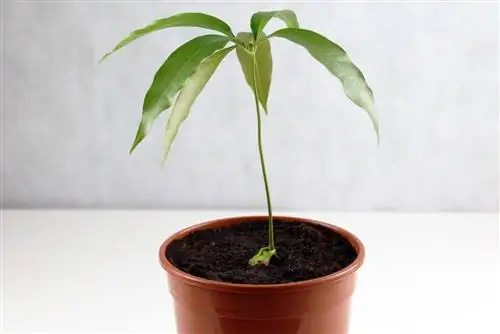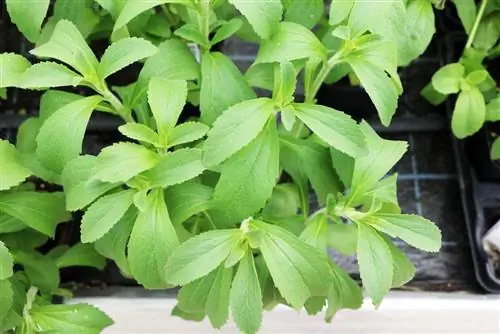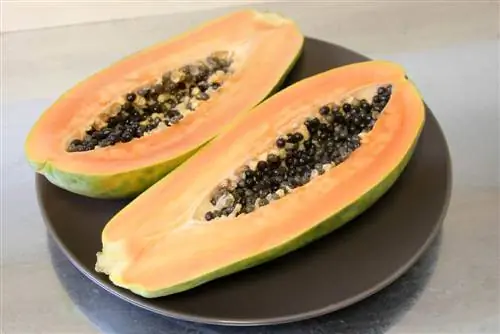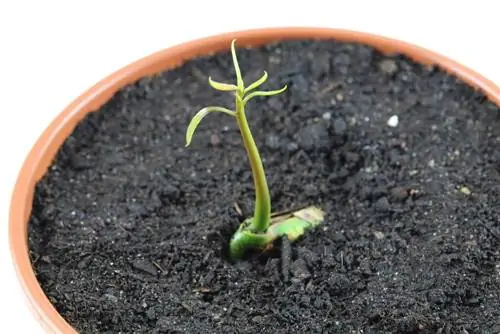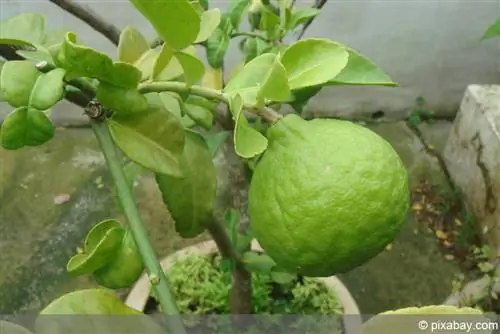- Author admin [email protected].
- Public 2023-12-17 03:39.
- Last modified 2025-01-24 12:45.
The mango tree is almost always cultivated and offered as a container plant in our latitudes. This has purely practical reasons, as it doesn't like temperatures below 15°C. This means that it is out of the running as an outdoor plant given our winter temperatures. But in a suitable container it refines the terrace, balcony, room, hallway or even a cozy garden corner in summer. If you're lucky and the mango has a perfect location, you might even be able to enjoy the flowers and fruit after a few years.
Location
In any case, this tropical fruit tree needs warmth. Temperatures between 24°C and 30°C are ideal. Even in winter the temperature must not drop too much, minimum 15°C. Ideal locations are heated greenhouses, winter gardens or indoor spaces. In summer also the terrace, garden or balcony, but with the possibility of moving for the cold season.
Outdoors, the mango tree wants to be protected from the wind. As a young plant, it does not tolerate direct sunlight all day long. It should then be shaded somewhat. After a few years, the blazing midday sun no longer bothers him. Mango trees need a lot of light all year round.
As a tropical, subtropical tree, it naturally loves high humidity. However, it has been found that the mango tree can adapt relatively well to low humidity without being damaged.
The growing mango should only be placed outdoors from the age of two, in the summer. Then the blazing sun and occasionally cooler temperatures can no longer harm the tree. Of course, you can always leave the mango tree in the house and cultivate it as a houseplant. A bright kitchen or bathroom are well-suited locations in the house. It is consistently warm here and the humidity is higher than in other living spaces.
Substrate & Soil
Permeable to water and air as well as nutrient-rich and slightly acidic, these are the main qualities that the substrate for a mango plant should have. These properties are best achieved with a mixture of humus soil, peat and sandy loam or with compost, coconut soil and ordinary garden soil. The pot should be quite high and have a good drainage layer. Mango trees form long taproots with many side branches. They don't tolerate waterlogging well at all.
Pouring
Young mangoes like it when the substrate is always kept slightly moist. After two to three years, the trees prefer it to be a little drier. Then it's best to check whether the substrate is already dry before watering again. A rule of thumb is that the more leaves the plant has, the thirstier it is.
It is best to always water with low-lime water, such as rainwater or stale tap water. Once a week is usually enough. Be sure to avoid waterlogging. The leaves, on the other hand, like to be sprayed daily. In particularly dry rooms, you can also place a water bowl near the plant pot.
Fertilize
If you grow the plant yourself from a seed, you only start fertilizing after the second or third month. A commercially available organic liquid fertilizer for houseplants is best. You start with a highly diluted mixture that you add to the irrigation water once a month.
Then slowly increase the ration and finally fertilize once a week. Don't be surprised if the mango plant shoots up quickly, but the leaves grow quite sparsely. This is completely normal for the first year. If the mango overwinters in a warm location, it can be fertilized all year round. If it is a little cooler, you can take a break from fertilizing during this time.
Cutting
The mango tree is an evergreen tree, it doesn't actually need any pruning. As the tree grows, you can make it branch more with a few targeted cuts. The best time for this is winter time. Sick or dried branches as well as water shoots that are currently sprouting can be removed all year round, ideally as soon as possible. The dry branches are cut down to the lush, green section.
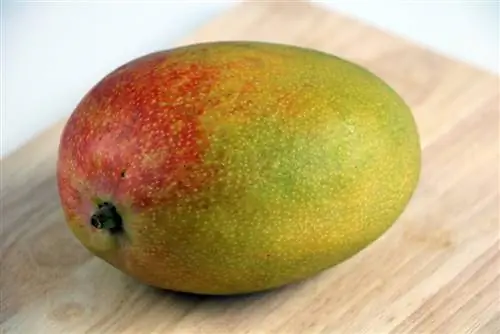
If you want to help a long-growing shoot to branch, the branch is cut directly above the second or third leaf base.
cultivation
You can't exactly get a young mango tree from the nursery next door. You will also have to look for a while for mango seeds. The cheapest and most exciting way to get a mango tree is the “do it yourself” route. Delicious mangoes can now be found almost everywhere. However, you should set high quality standards when purchasing the fruit. The fruit should be tasty, ripe and undamaged. Then you can start breeding immediately after consumption.
The Seed
The riper the fruit, the easier it is to remove the seeds and the more successful the germination. Since the mangoes for discounters and supermarkets are often not really ripe or may have been treated with germ-inhibiting agents, it is best to buy an organic mango.
Tip:
You can recognize a really ripe mango by its smell. The shell can look a bit wrinkled. In any case, the pulp will give slightly under gentle pressure. Tiny black dots on the peel are also a good sign of ripeness.
The first steps are as follows:
- Separate the mango flesh lengthwise from the core on both sides with a cut
- Remove the juicy pulp from the peel with a tablespoon and enjoy
- remove the core from the pulp
- clean the core thoroughly, there should be no more fruit residues
- let the core dry for a few days
- drill the core at the tip and separate the shell halves with a knife
- important: the seed inside is soft and must not be damaged
- either place the seed in the open, clean bowl in the soil or
- the seed removed intact from the shell
Sowing
The best time to plant the seeds is late spring, this is the time of maximum brightness, which is important for successful germination. Since it is a fairly large core, it can be a larger cultivation container right from the start. First, good drainage is placed over the drain holes.
Expanded clay, pebbles or pottery shards are suitable. Then add the growing soil or a nutrient-poor substrate mixture. It is important that the substrate is free of mold. Coconut fibers are well suited. It is best to sterilize potting soil or your own mixtures in the microwave or oven for at least 10 minutes at 150°C.
The seed that is still in the slightly opened shell is placed horizontally in the soil about two to three centimeters deep. The shellless seed also comes flat into the substrate, but is only lightly covered with soil. This will germinate after just 10 days. With the peel on, germination begins after three weeks at the earliest.
The seeds used must now be regularly sprayed with water. You can increase the humidity with a transparent film. The temperature should be well over 25°C. The warmer the substrate the better, but not over 30°C.
Germ, young plant
The pot needs a bright location at the latest when something green appears. The shoot grows up to 20 centimeters high and initially has four leaves. They are reddish in color and quite floppy. But that soon changes, the leaves turn green and more leaves follow. The spray bottle is still sufficient for watering. Under no circumstances should you spray in direct sunlight. In any case, the plant should not be exposed to the midday sun. The first swell occurs after two months at the earliest. Since the growing pot is relatively large, the mango only needs a new, larger pot after a year.
Repotting
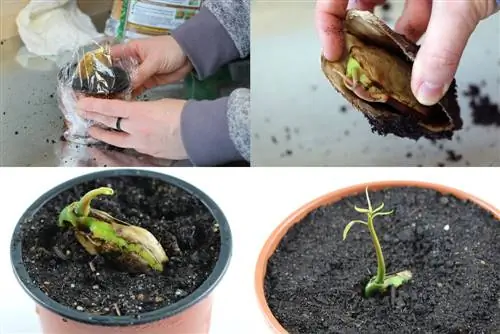
Repotting will be necessary for the first time after the 2nd year at the latest. In any case, when the tree is almost 40 centimeters high and the pot has roots. The substrate can then contain equal parts of mature compost and light loamy garden soil. Whenever you repot, you should always ensure there is a good drainage layer so that no waterlogging occurs. The further repotting can then be handled as you feel. So whenever the mango seems too small for the pot or the pot has roots.
Wintering
As a resident of the tropics and subtropics, the mango tree naturally does not take a proper winter break. This means that in a warm house as a houseplant or in a greenhouse there is no need to observe a special rest period. This applies to both watering and fertilization. The situation is different if the plant is moved to a cooler (but not below 15°C) location in winter. Most of the time there is less light. As a rule of thumb for the location in winter, you can remember: the cooler the tree is in winter, the less light it gets, the less watering and fertilizing will be necessary. This situation usually occurs when the mango spends the summer in the garden or on the balcony and is then placed in the hallway or winter garden in the winter.
Fruit formation
If you get a mango tree in a pot in our latitudes to not only bloom, but also to bear fruit, you can consider yourself really lucky. It's possible, but honestly, quite rare. Most of the time there is simply not enough light and heat. Which most plant lovers don't mind at all, because the mango tree itself is a beautiful tree.
The best chance of producing fruit is when grown in a heated greenhouse or winter garden. The light must then be added artificially via plant lamps. Even with these optimal conditions, you still need a fair amount of patience. The first flowering will only occur after about five years. Then, since this doesn't happen in the wild, you have to use a brush to help with pollination.
Varieties, purchasing
It's best to choose the right mango from a well-stocked fruit dealer. Asian or other international grocery stores also sometimes carry wonderful varieties that are not offered in supermarkets. There are around 1,000 species of mangoes worldwide, new varieties are constantly being added and old species are becoming extinct. In Germany there are around 30 mango varieties. They come mainly from India, Southeast Asia and South America.
Known varieties include:
- Kent: large, roundish, green-yellow, sweet and juicy, small core
- Nam Dok Mai: light yellow, elongated, sweet
- Haden: round, predominantly red, aromatic, very often on offer
- Manila Super Mango: yellow, very sweet
Tip:
If you want to grow your own from one seed, it is recommended to try out several varieties. It's best to have two kernels of the same variety. The effort is not significantly greater and the chance of having a good germinating seed is greater.
Some nurseries and online mail order companies offer mango trees in containers of various sizes. Prices start at 40EUR and increase with size. Most advertising also mentions fragrant flowers and a bountiful harvest. Before you go shopping enthusiastically, you should be sure that you can meet the high requirements for brightness and temperature, especially for possible fruit formation.
Diseases & Pests
The mango tree is not particularly susceptible to diseases and pests. However, like almost all houseplants, it quickly becomes vulnerable if it is too wet or too dry.
Sunburn is noticeable through brown spots on the leaves. This happens quickly behind the glass of a south-facing window. Then be sure to provide shade during lunchtime.
As with all houseplants, the spider mite is the most common pest on a potted mango tree. The young shoots wilt and turn black. If the plant is infested, you should shower it immediately and increase the humidity, as spider mites love it dry. If the infestation is noticed early enough, these measures can help, so that chemical treatment of the plant is not necessary.
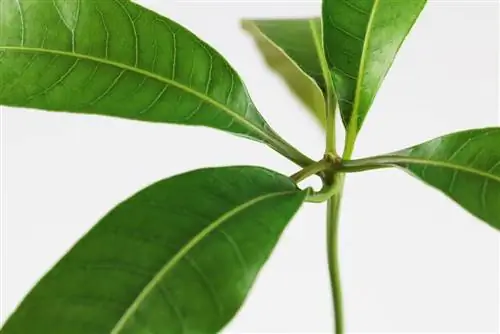
Reducing the pH value can be achieved once or twice a year with aluminum sulfate. This can prevent possible growth disorders.
When watering you should always keep a close eye on the substrate. If the mangoes are watered too much or left too cold, they can easily rot.
The soil then smells musty and moldy and is covered with gray-white deposits. Then you have to act quickly to save the entire plant. The substrate must be completely replaced and you will not be able to avoid using fungicides.
Conclusion
If you enjoy seeing how a mango seed you plant yourself becomes a shapely tree in a pot, you should definitely try it out. It is better not to have a rich harvest of sweet fruits as your only goal. To grow and care for a mango tree, it is generally sufficient to take the three key words of warmth, light and humidity to heart. So you will enjoy these robust, fast-growing exotics for a long time.

